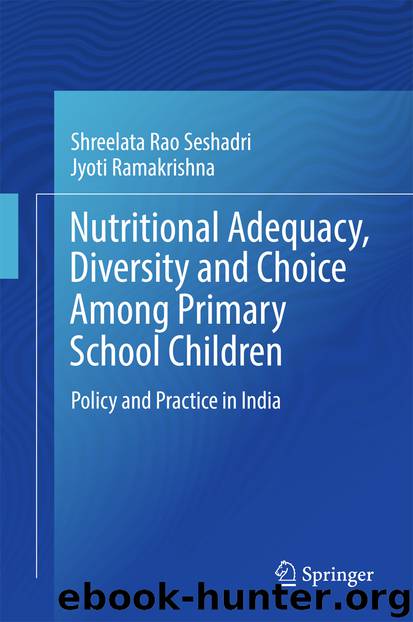Nutritional Adequacy, Diversity and Choice Among Primary School Children by Shreelata Rao Seshadri & Jyoti Ramakrishna

Author:Shreelata Rao Seshadri & Jyoti Ramakrishna
Language: eng
Format: epub
Publisher: Springer Singapore, Singapore
4.6 Addressing the Nutritional Vulnerability of Tribal Children
Tribal children in India continue to be nutritionally vulnerable. Diets have changed considerably in tribal households, due to several factors: household income, access to agricultural land, changes in agricultural practices; as well as household level factors that constrain dietary availability and diversity. Dietary choices made by children have changed: preferences have moved away from traditional healthful choices such as ragi to largely rice-based options. The monthly food ration distributed to tribal families as well as the midday meal provided to children in schools are important and valued contributors to the food security of tribal families; and their reliance on them is evident.
Given what we know about the nutritional status of tribal children, their food intake, and household factors that determine dietary adequacy, availability and diversity, a few critical recommendations emerge as a guide for future action:(i)At the policy level, (a) The monthly food ration needs to not only continue, but perhaps also be expanded to ensure food security. Given the economic constraints faced by these families, the seasonal nature of their employment, as well as low land ownership, tribal families find it exceedingly difficult to supplement the government rations from their own resources. Promoting traditional food systems through policy and programmatic interventions is critical to support tribal families to maintain their dietary diversity and variation in food choices. Due to easy availability of certain foods, ease of preparation and shifting food preferences of the children, tribal families are moving away from traditional foods and adopting food choices that may be less healthy and nutritious than their traditional diets would have been. Ensuring easier access to traditional foods such as ragi as well as familiar root vegetables and meat products through the food distribution system would significantly enhance their ability to preserve traditional diets; (b) intersectoral action is critical: agriculture and forest policies should support families to supply their own food needs, and make it financially and otherwise viable for them to do so.
Download
This site does not store any files on its server. We only index and link to content provided by other sites. Please contact the content providers to delete copyright contents if any and email us, we'll remove relevant links or contents immediately.
| Administration & Medicine Economics | Allied Health Professions |
| Basic Sciences | Dentistry |
| History | Medical Informatics |
| Medicine | Nursing |
| Pharmacology | Psychology |
| Research | Veterinary Medicine |
1610396766 (N) by Jo Ann Jenkins(1566)
Elizabeth Is Missing by Emma Healey(1565)
Economics and Financial Management for Nurses and Nurse Leaders, Third Edition by Susan J. Penner RN MN MPA DrPH CNL(1448)
McGraw-Hill Nurses Drug Handbook by Patricia Schull(1401)
Cherry Ames Boxed Set, Books 1 - 4 by Helen Wells(1333)
NCLEX-RN Prep Plus 2019 by Kaplan Nursing(1308)
The Language of Kindness by Christie Watson(1303)
Home. by Sarah Graham(1300)
Spiritual Midwifery by Ina May Gaskin(1282)
Cherry Ames, Student Nurse by Helen Wells(1275)
Cherry Ames Boxed Set, Books 5 - 8 by Helen Wells(1236)
Whoever Tells the Best Story Wins: How to Use Your Own Stories to Communicate with Power and Impact by Annette Simmons(1231)
Cracking the Nursing Interview by Jim Keogh(1217)
1476763445 by Liz Fenton(1175)
Getting Started with Arduino by Massimo Banzi(1133)
Dementia by June Andrews(1127)
Children's Medicines by Edward A. Bell(1102)
Cherry Ames, Army Nurse by Helen Wells(1083)
Shadows of the Workhouse: The Drama of Life in Postwar London by Jennifer Worth(1055)
